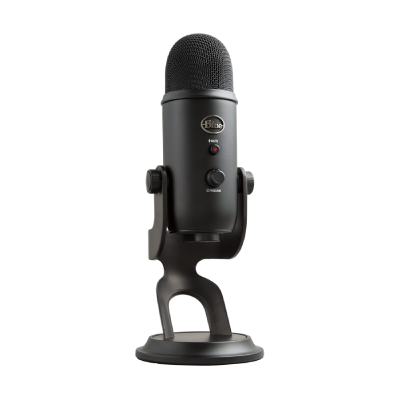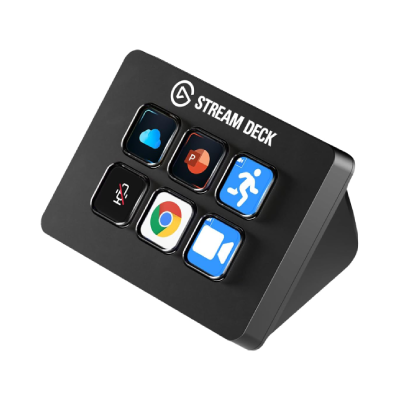Scene transitions in OBS Studio are virtual effects that switch from one scene, source, or part of your content to another. Transitions can make your stream look sleeker and more professional when changing scenes and give your content a more engaging feel.
Scene transitions can be an essential feature, adding to the production value and helping to showcase your branding more for extra engagement in your stream.
In this article, we will show you how to set up simple transitions in OBS Studio and how to create your custom transitions. This will allow you to fully integrate your brand into your stream and achieve a more professional look.
Setting up default transitions in OBS Studio
OBS Studio already includes the classic transitions you are probably used to: cut, fade, swipe, fade to colour, and Luna wipe. To add a transition to your scenes, you just need to click on the little + button on the scene transitions dock and choose the type of transition you would like. The different kinds of transitions that you can choose from are as follows:

- A cut is an instant switch to the scene of choice, which you see primarily in TV shows and movies.

- A fade is a gradual switch to the scene where the current scene fades out while the active scene fades in over a select period. This time can be changed in milliseconds, but the default 300ms is an excellent place for most people with all transitions. Feel free to experiment with the duration to find what best suits your stream.

- A swipe transition is where the new scene slides in from an up, down, left or right direction. You can change the duration like the other transitions and whether the new scene slides in over the old scene or the old scene slides out as the new scene comes in.

- A Fade to Colour transition is similar to the fade transition, but rather than just fading from the active scene to the scene you’re switching to, it fades to a colour of your choice briefly and then fades to your next scene to which you can customise the colour to the colour scheme of your other stream assets.

- A Luna Wipe transition layers the new scene on top of the old scene but with a mask that “wipes” over it to make a smooth transition between them.

- Stinger Transitions are a more ‘professional’ type of transition that you will have already seen but may not know you have. Have you ever watched a sports broadcast when they transitioned to an instant replay, and they had a cool animation? Yup, that’s a stinger transition. They look all fancy and can be customised in any way you see fit, limited only by your animation!
Setting up advanced transitions in OBS Studio
Move Transition Plugin
Once you have mastered the basics or simply want a more custom look at your transitions, you can move beyond the pre-baked transitions in OBS and templates from companies like Nerd or Die and create more advanced transitions completely custom-tailored for your stream.
If you aren’t interested in a stinger-style transition and would like something that looks seamless and immersive, then you could go for a plugin called Move Transition by Exeldro. This plugin for OBS allows you to create “filters” in which the plugin can move sources in the scene by the touch of a button. It could save you resources, which means your computer won't slow down as much as it may do by using a traditional transition to another scene, as everything in the scene is loaded. You are just moving those sources around the scene.

For example, if you want to transition a scene from a “Just Chatting” scene to a “Gaming” scene, I find it best practice to have your sources in nested scenes over having all the sources in one scene. More details and a tutorial on nested scenes will be coming soon, but a watered-down version is simply just by putting your full camera and game sources in two separate scenes. Then, in your “live” scene, you add a new source, select “scene, "and then add your camera and game to the current scene through this method.

Next, you must right-click on your scene, click filters, add a new Move Source filter and name it “Full Camera”, then add another and call it “Small Camera”.

With the Full Camera filter selected, you must ensure the Source is your Camera scene because this is the source from which we are moving. The duration is a personal preference, but I use 600 for this guide. Then, you scroll down to the Transform box, where the main magic happens.
You need to click on your camera source in the preview or the Sources list so it selects your camera and right-click > Transform > Fit to Screen to make the camera scene the full size of the scene. Once that is done, you can then click the “Get Transform” button on the filter so it gets the coordinates of where your source is, how big it is, etc.

Once done, you must do the same for the Small Camera filter. So first, you need to resize the camera on the preview frame by clicking on it and dragging the corners to the size you want, then dragging the camera source to where you want it. Then, you click on the Small Camera filter and do the same as you did for the Full Camera filter. Ensure the camera is the selected source, with the duration at 600ms, and then click “Get Transform.”

The move transition plugin can be used on any source in the scene, so it doesn’t just have to be used on your camera. It can be used on your game, stream alerts, and chat box, and they can all be activated with the keyboard shortcuts available in OBS already. If you have external hardware like an Elgato Stream Deck, you could bind these effects to a button on there and activate it.
Custom Stinger Transitions
Custom stinger transitions can be more tricky because you must make all the animations, import any/all assets you would like into the project, and create it from scratch.
For this example, I will be using Adobe Premiere Pro and one of my stream emotes, but free software, like Canva, is available to make your desired logo/graphic if you don’t already have one. If you have Adobe Suite, you can use Photoshop or Illustrator. You can also use free editing software like Davinci Resolve to make the stinger.
The following instructions will be for Adobe Premiere Pro, your editing software may vary with settings or options.
First, you need to create a new project in your chosen editing software, create a new sequence, and give it the resolution of your stream. Mine is 1920x1080, so I will create the sequence with these settings.
Next, I will create 3 colour matte items with three separate colours by right-clicking on the project panel, selecting New Item, Colour Matte, and then choosing a colour. Do this for all three colours you want for the stinger.

Next, you must import and create a mask on the three colour mattes. To do this, drag each colour matte to the timeline on separate video tracks, then select the first colour matte, click on Effect Controls, change the scale to 200, and rotate to 25°. On the Opacity dropdown, create a mask by clicking the rectangle button.

Now, you must alter the mask on the first two colours to be a thin but long rectangle so the rectangle can be seen throughout the canvas when passing across the canvas.

Now, we don’t need a mask with the third colour matte, so leave it as it is and get ready to position the colours in the order you want.
First, we need to grab our first colour. For this example, my blue matte will be colour #1, Purple is #2, and White is #3. Once you have colour 1 selected, drag it to the bottom right corner of the screen so it’s just off the canvas, then make sure you’re at the start of the timeline, then click the little stopwatch icon in the Effect Controls tab to start recording keyframes and then go to 1 second in the timeline and drag colour 1 to the opposite corner of the canvas so again, it just drops off the screen. This would have created a new keyframe, and if you scroll through your timeline, you will see colour 1 move across the screen.

Once you have done this, you just need to do the same thing for colour 2 and colour 3. The only other thing you need to do is make sure the different colours have a slight gap, so they leave a sort of ‘trail’ as they slide across the screen.

Now, if you want to add your logo to the stinger to make it more personal to your stream, you can go to the end of the timeline and move colour 3 fully off the canvas so it animates off to the top left corner.

If you want to add your logo or image, you just need to drag that onto the timeline and place it roughly in the middle, where the first two colours cover the centre of the screen. Next, you need to click the stopwatch on the Opacity tab and drag the value from 100% to 0%, then skip forward a few frames so the colours go over the image, then change the value again from 0% to 100% so it fades in as the first two colours pass over. Once you have done this, skip ahead frames until colour 3 is about to cross over the image, click the keyframe button to make a new keyframe, and continue skipping keyframes until colour 3 has finished passing the logo and drop the Opacity to 0%. It should fade out as it passes.

All that is left now is to render it. Add the project to the render queue, and for the format, you would need to select Quicktime, the Video Codec as None (Uncompressed RGB 8-bit), and ensure Render at Maximum Depth is checked. The Depth is 8-bpc + Alpha is selected along with Use Maximum Render Quality and finally, export it.

Once it has been exported fully, you must add a new stinger transition, click browse on Video File, and select the stinger we just exported from our editing software. Next, the transition point type should be frame, and to get the precise frame, we will need to check when the entire screen is covered in our timeline in the editing software. In my case, the whole screen is covered in frame 42 and click OK.

To test it, we just need to switch scenes and watch the new stinger we made do its magic!




